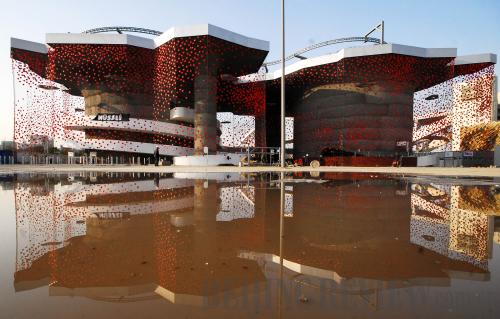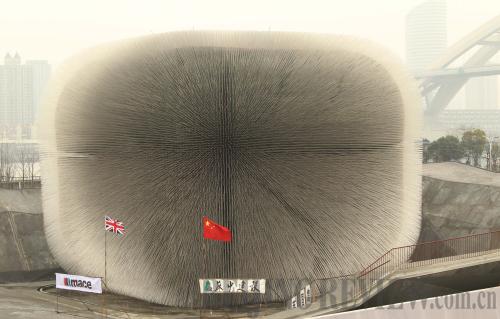|
 |
|
CLEVER FACADE: The interactive intelligent facade envelops the Switzerland Pavilion, which can save energy in the daytime and is active at night (XINHUA) |
Showcasing the progress that humanity has made in science and technology is an important part of the upcoming World Expo in Shanghai. The new products displayed in expo pavilions reflect progress achieved by means of various technologies. These advanced technologies offer amusement as well as education, and visitors to the expo can see humanity's future possibilities from these technologies.
Medical Check-Up Capsule at Israel Pavilion
(National Pavilion Day: May 6)
A thumb-sized "capsule" has been unveiled at the Israel Pavilion, which is in actuality a mini-camera that can be swallowed and perform a medical check-up from within the human body. The camera is then discharged, causing no pain to patients at all.
The pavilion consists of three areas: the Whispering Garden, the Hall of Light and the Hall of Innovations. The Whispering Garden is an orchard that greets visitors as they enter the building. Inside the natural stone is the Hall of Innovations, symbolizing links with the Earth and history, and the recycling of natural resources. Under the transparent glass is the Hall of Light, symbolizing technology, transparency, brightness and the future. The medical check-up capsule is displayed in the Hall of Innovations.
Cloud Droplets at MeteoWorld Pavilion
(Pavilion Day: May 9)
The MeteoWorld Pavilion, funded by the UN World Meteorological Organization (WMO), uses a transparent white membrane structure to give visitors the feeling of walking through the clouds. Small mist sprayers are evenly distributed through the membrane structure. When the sprayers are switched on, the entire pavilion will appear to be a white floating cloud situated within a mysterious mist. When the angle of sunshine is less than 42 degrees, visitors within the expo site may enjoy a "mirage"—"Rainbow in the Mist." According to designers, the pavilion will "float" in the center of a shallow pond and be accessible from three directions.
A hi-tech weather station has been built inside the pavilion. It showcases the most cutting-edge technologies, which are also applied to WMO's demonstration project, the Multi-Hazard Early Warning System. Here visitors can experience the great changes created by early warning technologies for disaster prevention in cities of the future. In the meantime, it will serve during the Expo to provide timely and accurate weather forecast and services.
Metal Sphere at Germany Pavilion
(National Pavilion Day: May 19)
A cone-shaped structure housing a revolving metal sphere is the highlight of the Germany Pavilion. The sphere, 3 meters in diameter and covered with LEDs, will be activated by the noise and movement of spectators. The Energy Source is where energy is generated to bring a city to life. It is the heart of "balancity," the theme of the pavilion.
It is here that the Energy Source show is presented, the climax of the voyage through the pavilion. The show can be viewed by 600 people at any one time. Visitors play a leading role in the show, controlling what happens, and setting the sphere in motion. The 600 spectators are divided into two groups, and will quickly realize that they can set the sphere swinging by making movements and shouting loudly. The further the sphere swings, the more intense the colors become. The sphere's energy is reflected through the room—on the balustrades, the walls, the ceiling and the floor.
The swinging triggered by the audience will then increase in speed and momentum and the sphere will start to move in a circular motion. Numerous different images of Germany and balancity pass before spectators' eyes. The sphere will then come to a halt and remain silent. The room is bathed in green light and a pleasant natural atmosphere sets in beneath a blue sky. From within a globe, a seed will grow and slowly turn into a flower. Visitors will leave a pavilion that is positively charged with the energy that they have generated together.
Transparent Cement at Italy Pavilion
(National Pavilion Day: June 2)
Visitors to the Italy Pavilion will see constantly changing images of the building's life at different times throughout the day, because a new type of "transparent cement" has been used for the exterior of the pavilion. Transparent panels made of this innovative material were developed by Italcementi, and will cover 40 percent of the total surface area of the building.
Thanks to the new concrete, a natural radiance will permeate the interior when the sun shines, while the interior artificial lighting at night will shine onto the streets and reveal the shadows of people moving inside. Clearly, the use of these panels can engender a reduction in power consumption that will become significant in large buildings.
The diaphanous quality of the product originates from special resins placed in the cement mix that can be shaped into large solid panels—an invention patented by Italcementi researchers. Different combinations of colors and resin qualities can produce the most astonishing light effects, thus making the product extremely versatile.
Another feature of this new type of cement relates to casting operations. In spite of the material's complexity, it can be poured directly into "moulds" at the building site with a significant decrease in production and deployment costs. Additionally, the strength and compactness of this "transparent concrete" may also allow for new and diversified applications, including potential structural use.
In addition to transparent cement, the pavilion will also be equipped with a new ceramic floor material that reduces polluting agents present in the air by up to 70 percent. Active clean air and antibacterial ceramic is an innovative technology developed by Fiandre, which gives porcelain stoneware slabs antibacterial properties and helps combat pollution through a photocatalytic process. In addition, because it reduces the surface tension of the water, it boasts a self-cleaning capacity as well as significant antimicrobial and antifungal properties.
The Interactive, Intelligent Facade and IMAX Film at Switzerland Pavilion
(National Pavilion Day: August 12)
The Switzerland Pavilion is wrapped in an interactive intelligent facade, which consists of a curtain of woven aluminium elements under which visitors pass to access the urban area on the ground floor of the building. The facade also includes LED lights comprised of an energy source, a storage unit and a consumption unit. The energy produced is made visible in the form of flashes that are triggered by light from the pavilion's surroundings, including light from the sun or flashes made by cameras of visitors. Because of the storage of energy in each individual cell, the facade will also be active at night, when the cells will trigger each other.
In this pavilion, visitors can proceed from the ground floor to the roof to view classic Swiss scenery by riding a cable car. During a 10-minute journey, 50 binocular stations set up along the ramp will provide visitors with three-dimensional glimpses of innovative and sustainable Swiss success stories.
At the top end of the ramp in the exhibition area, visitors can view a 10-meter-high projection screen in the atrium. The IMAX film, The Alps, showcasing magnificent Swiss mountain scenery, will be projected onto the screen.
Gömböc and Wooden Rods at Hungary Pavilion
(National Pavilion Day: August 22)
The Hungary Pavilion is decorated with hundreds of wooden rods. Every single element of the wooden installation performs like a musical instrument. The system of nearly 600 moving and light emitting sound boxes creates a wavering sound space. The inner space of the pavilion is illuminated by natural sunlight in the daytime, while at night it turns into a starlit sky through the lights built in the sound boxes. The hanging and vertically-shifting wooden rods will make visitors feel as though they are walking in a forest, and their rarefaction refers to glades, just like squares in the city.
Gömböc, a 2-meter-high solid plexiglass moving object, is the central element of the pavilion. Pronounced "goemboets," the new geometric shape created by Gábor Domokos and Péter Várkonyi is the first known homogenous object with one stable and one unstable equilibrium point, thus possessing a total of two equilibria on a horizontal surface.
It shares a close philosophical relation with yin and yang in ancient Chinese philosophy, both symbolizing the pursuit of harmony and balance. This is what Hungarians wish to achieve in urban development as well. Its harmonic movement is similar to the pulsation of a city; this feature is magnified by the structure of the pavilion through its dynamically shifting vertical wooden rod elements, creating density at the same time. The Gömböc stands as a symbol of dual harmony and equilibrium. The designers of the Hungarian Pavilion project this feature of the Gömböc upon the entire country: Just like the Gömböc, Hungary always recovers.
The Seed Cathedral at UK Pavilion
 |
|
STRETCHING TO THE FUTURE: Some 60,000 slender transparent rods form the six-storey-high "Seed Cathedral," the centerpiece of the UK Pavilion (REN LONG) |
(National Pavilion Day: September 8)
The centerpiece of the UK Pavilion is the six-storey Seed Cathedral formed from some 60,000 slender transparent rods, which extend from the structure and quiver in the breeze. During the day, each of the 7.5-meter-long rods act as fibre-optic filaments, drawing on daylight to illuminate the interior, and thus creating a contemplative, awe-inspiring space. At night, light sources at the interior end of each rod allow the whole structure to glow.
Inside the Seed Cathedral, which is the core exhibition of the pavilion, visitors will be invited to watch, touch and identify the seeds of different plants. They will be surrounded by seeds in the 20-meter-high hollow cube-like structure, with the seeds embedded in the walls and ceilings. The seeds demonstrate the concept of sustainability, the diversity of nature and the potential of life. |